Sensing Based on Plasmon-Induced Transparency in H-Shaped Graphene-Based Metamaterials
Abstract
:1. Introduction
2. Structure and Theoretical Model
3. Results and Discussion
4. Conclusions
Author Contributions
Funding
Data Availability Statement
Conflicts of Interest
References
- Kida, N.; Miyamoto, T.; Okamoto, H. Emission of Terahertz Electromagnetic Waves: A New Spectroscopic Method to Investigate Physical Properties of Solids. J. Phys. Soc. Jpn. 2021, 91, 112001. [Google Scholar] [CrossRef]
- McIntosh, A.I.; Yang, B.; Goldup, S.M.; Watkinson, M.; Donnan, R.S. Terahertz spectroscopy: A powerful new tool for the chemical sciences? Chem. Soc. Rev. 2012, 41, 2072–2082. [Google Scholar] [CrossRef]
- Isaac, T.H.; Barnes, W.L.; Hendry, E. Determining the terahertz optical properties of subwavelength films using semiconductor surface plasmons. Appl. Phys. Lett. 2008, 93, 241115. [Google Scholar] [CrossRef]
- Liu, W.-Q.; Lu, Y.-F.; Jiao, G.-H.; Chen, X.-F.; Li, J.-Y.; Chen, S.-H.; Dong, Y.-M.; Lv, J.-C. Terahertz optical properties of the cornea. Opt. Commun. 2016, 359, 344–348. [Google Scholar] [CrossRef]
- Rogalin, V.E.; Kaplunov, I.A.; Kropotov, G.I. Optical Materials for the THz Range. Opt. Spectrosc. 2019, 125, 1053–1064. [Google Scholar] [CrossRef]
- Ge, H.; Jiang, Y.; Xu, Z.; Lian, F.; Zhang, Y.; Xia, S. Identification of wheat quality using THz spectrum. Opt. Express 2014, 22, 12533–12544. [Google Scholar] [CrossRef] [PubMed]
- Mathanker, S.K.; Weckler, P.R.; Wang, N. Terahertz (THz) applications in food and agriculture: A review. Trans. ASABE 2013, 56, 1213–1226. [Google Scholar]
- Wang, Y.; Cui, W.; Ren, Y.; Li, Z.; Zhang, L.; Lei, W.; Huo, Y.; He, Z. Tunable perfect absorption and versatile applications based on a simple black phosphorus metasurface in terahertz. Infrared Phys. Technol. 2024, 136, 105091. [Google Scholar] [CrossRef]
- Chan, W.L.; Deibel, J.; Mittleman, D.M. Imaging with terahertz radiation. Rep. Prog. Phys. 2007, 70, 1325. [Google Scholar] [CrossRef]
- Rao, C.; Biswas, K.; Subrahmanyam, K.; Govindaraj, A. Graphene, the new nanocarbon. J. Mater. 2009, 19, 2457–2469. [Google Scholar] [CrossRef]
- Rao, C.; Matte, H.R.; Subrahmanyam, K. Synthesis and selected properties of graphene and graphene mimics. Acc. Chem. Res. 2013, 46, 149–159. [Google Scholar] [CrossRef] [PubMed]
- Tongay, S.; Berke, K.; Lemaitre, M.; Nasrollahi, Z.; Tanner, D.; Hebard, A.; Appleton, B. Stable hole doping of graphene for low electrical resistance and high optical transparency. J. Nanotechnol. 2011, 22, 425701. [Google Scholar] [CrossRef]
- Balandin, A.A.; Ghosh, S.; Bao, W.; Calizo, I.; Teweldebrhan, D.; Miao, F.; Lau, C.N. Superior thermal conductivity of single-layer graphene. Nano Lett. 2008, 8, 902–907. [Google Scholar] [CrossRef]
- Pisani, L.; Montanari, B.; Harrison, N. A defective graphene phase predicted to be a room temperature ferromagnetic semiconductor. New J. Phys. 2008, 10, 033002. [Google Scholar] [CrossRef]
- Gonçalves, P.; Stenger, N.; Cox, J.D.; Mortensen, N.A.; Xiao, S. Strong light–matter interactions enabled by polaritons in atomically thin materials. Adv. Opt. Mater. 2020, 8, 1901473. [Google Scholar] [CrossRef]
- Liu, C.; Bai, Y.; Zhou, J.; Zhao, Q.; Qiao, L.; Liu, C.; Bai, Y.; Zhou, J.; Zhao, Q.; Qiao, L. A review of graphene plasmons and its combination with metasurface. J. Korean Ceram. Soc. 2017, 54, 349–365. [Google Scholar] [CrossRef]
- Liu, Y.-Q.; Liu, P.-K. Excitation of surface plasmon polaritons by electron beam with graphene ribbon arrays. J. Appl. Phys. 2017, 121, 113104. [Google Scholar] [CrossRef]
- Ren, Y.; Cui, W.; Yang, Z.; Xiong, B.; Zhang, L.; Li, Z.; Lu, S.; Huo, Y.; Wu, X.; Li, G.; et al. Ultra-broadband and wide-angle solar absorber for the All-MXene grating metamaterial. Opt. Mater. 2024, 149, 115073. [Google Scholar] [CrossRef]
- Han, Z.; Bozhevolnyi, S.I. Radiation guiding with surface plasmon polaritons. Rep. Prog. Phys. 2012, 76, 016402. [Google Scholar] [CrossRef]
- Zayats, A.V.; Smolyaninov, I.I.; Maradudin, A.A. Nano-optics of surface plasmon polaritons. Phys. Rep. 2005, 408, 131–314. [Google Scholar] [CrossRef]
- Zhang, J.; Zhang, L.; Xu, W. Surface plasmon polaritons: Physics and applications. J. Phys. D Appl. Phys. 2012, 45, 113001. [Google Scholar] [CrossRef]
- Zhao, M.; Li, H.; He, Z.; Chen, Z.; Xu, H.; Zheng, M. Novel oscillator model with damping factor for plasmon induced transparency in waveguide systems. Sci. Rep. 2017, 7, 10635. [Google Scholar] [CrossRef] [PubMed]
- Esfandiari, M.; Lalbakhsh, A.; Shehni, P.N.; Jarchi, S.; Ghaffari-Miab, M.; Mahtaj, H.N.; Reisenfeld, S.; Alibakhshikenari, M.; Koziel, S. Szczepanski, Recent and emerging applications of Graphene-based metamaterials in electromagnetics. Mater. Design 2022, 221, 110920. [Google Scholar] [CrossRef]
- Jiang, X.; Chen, D.; Zhang, Z.; Huang, J.; Wen, K.; He, J.; Yang, J. Dual-channel optical switch, refractive index sensor and slow light device based on a graphene metasurface. Opt. Express 2020, 28, 34079–34092. [Google Scholar] [CrossRef] [PubMed]
- Luo, L.; Wang, K.; Ge, C.; Guo, K.; Shen, F.; Yin, Z.; Guo, Z. Actively controllable terahertz switches with graphene-based nongroove gratings. Photonics Res. 2017, 5, 604–611. [Google Scholar] [CrossRef]
- Limonov, M.F.; Rybin, M.V.; Poddubny, A.N.; Kivshar, Y.S. Fano resonances in photonics. Nat. Photonics 2017, 11, 543. [Google Scholar] [CrossRef]
- Fernandes, D.E.; Lannebère, S.; Morgado, T.A. High Q-factor Fano resonances in coupled wire arrays with bulk structural asymmetry. Phys. Rev. B 2024, 109, 085123. [Google Scholar] [CrossRef]
- Chen, J.; Gan, F.; Wang, Y.; Li, G. Plasmonic sensing and modulation based on Fano resonances. Adv. Opt. Mater. 2018, 6, 1701152. [Google Scholar] [CrossRef]
- Sekkat, Z.; Hayashi, S.; Nesterenko, D.V.; Rahmouni, A.; Refki, S.; Ishitobi, H.; Inouye, Y.; Kawata, S. Plasmonic coupled modes in metal-dielectric multilayer structures: Fano resonance and giant field enhancement. Opt. Express 2016, 24, 20080–20088. [Google Scholar] [CrossRef]
- Francescato, Y.; Giannini, V.; Maier, S.A. Plasmonic systems unveiled by Fano resonances. ACS Nano 2012, 6, 1830–1838. [Google Scholar] [CrossRef]
- Zhang, S.; Genov, D.A.; Wang, Y.; Liu, M.; Zhang, X. Plasmon-induced transparency in metamaterials. Phys. Rev. Lett. 2008, 101, 047401. [Google Scholar] [CrossRef] [PubMed]
- Alharbi, R.; Irannejad, M.; Yavuz, M. A short review on the role of the metal-graphene hybrid nanostructure in promoting the localized surface plasmon resonance sensor performance. Sensors 2019, 19, 862. [Google Scholar] [CrossRef] [PubMed]
- Song, H.; Zhou, S.; Song, Y.; Wang, X.; Fu, S. Tunable propagation of surface plasmon-phonon polaritons in graphene-hBN metamaterials. Opt. Laser Technol. 2021, 142, 107232. [Google Scholar] [CrossRef]
- Tang, P.-R.; Li, J.; Du, L.-H.; Liu, Q.; Peng, Q.-X.; Zhao, J.-H.; Zhu, B.; Li, Z.-R.; Zhu, L.-G. Ultrasensitive specific terahertz sensor based on tunable plasmon induced transparency of a graphene micro-ribbon array structure. Opt. Express 2018, 26, 30655–30666. [Google Scholar] [CrossRef]
- He, Z.; Li, L.; Ma, H.; Pu, L.; Xu, H.; Yi, Z.; Cao, X.; Cui, W. Graphene-based metasurface sensing applications in terahertz band. Results Phys. 2021, 21, 103795. [Google Scholar] [CrossRef]
- Su, H.; Jiang, T.; Zhou, R.; Li, Z.; Peng, Z.; Wang, S.; Zhang, M.; Liang, H.; Li, I.L.; Ruan, S. High-sensitivity terahertz sensor based on Tamm plasmon polaritons of a graphene asymmetric structure. JOSA B 2021, 38, 1877–1884. [Google Scholar] [CrossRef]
- Wang, Y.; Chang, B.; Xue, J.; Cao, X.; Xu, H.; He, H.; Cui, W.; He, Z. Sensing and slow light applications based on graphene metasurface in terahertz. Diam. Relat. Mater. 2022, 123, 108881. [Google Scholar] [CrossRef]
- Li, Z.; Yang, N.; Liu, Y.; Li, L.; Zhong, Z.; Song, C.; He, Z.; Cui, W.; Xue, W.; Li, L.; et al. Tunable plasmonic optical responses and the sensing application in graphene-based metasurface. Diam. Relat. Mater. 2022, 126, 109071. [Google Scholar] [CrossRef]
- Garcia, J.H.; Rappoport, T.G. Kubo–Bastin approach for the spin Hall conductivity of decorated graphene. 2D Mater. 2016, 3, 024007. [Google Scholar] [CrossRef]
- Jabbarzadeh, F.; Heydari, M.; Habibzadeh-Sharif, A. A comparative analysis of the accuracy of Kubo formulations for graphene plasmonics. Mater. Res. Express 2019, 6, 086209. [Google Scholar] [CrossRef]
- Morimoto, T.; Hatsugai, Y.; Aoki, H. Optical Hall conductivity in ordinary and graphene quantum Hall systems. Phys. Rev. Lett. 2009, 103, 116803. [Google Scholar] [CrossRef] [PubMed]
- Sinitsyn, N.; Hill, J.; Min, H.; Sinova, J.; MacDonald, A. Charge and spin Hall conductivity in metallic graphene. Phys. Rev. Lett. 2006, 97, 106804. [Google Scholar] [CrossRef] [PubMed]
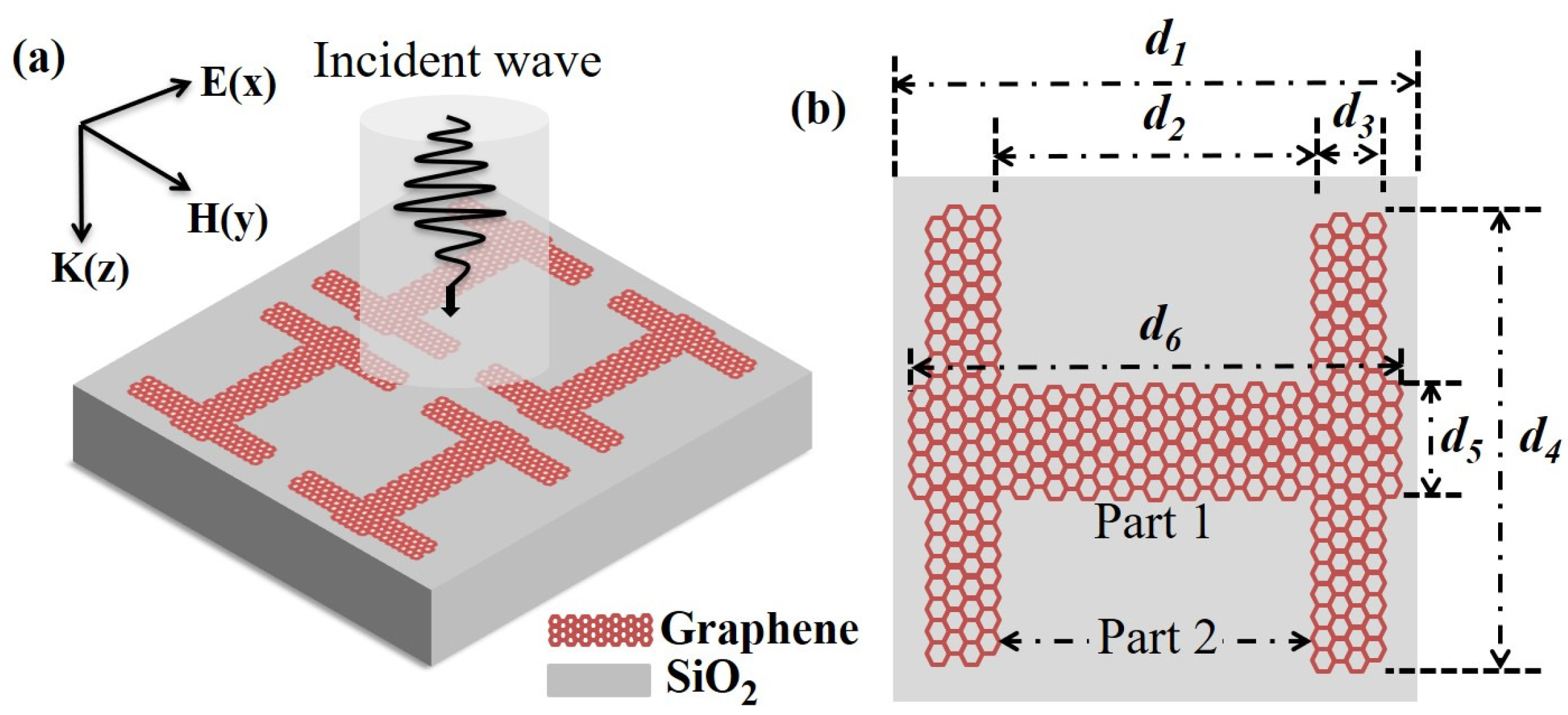
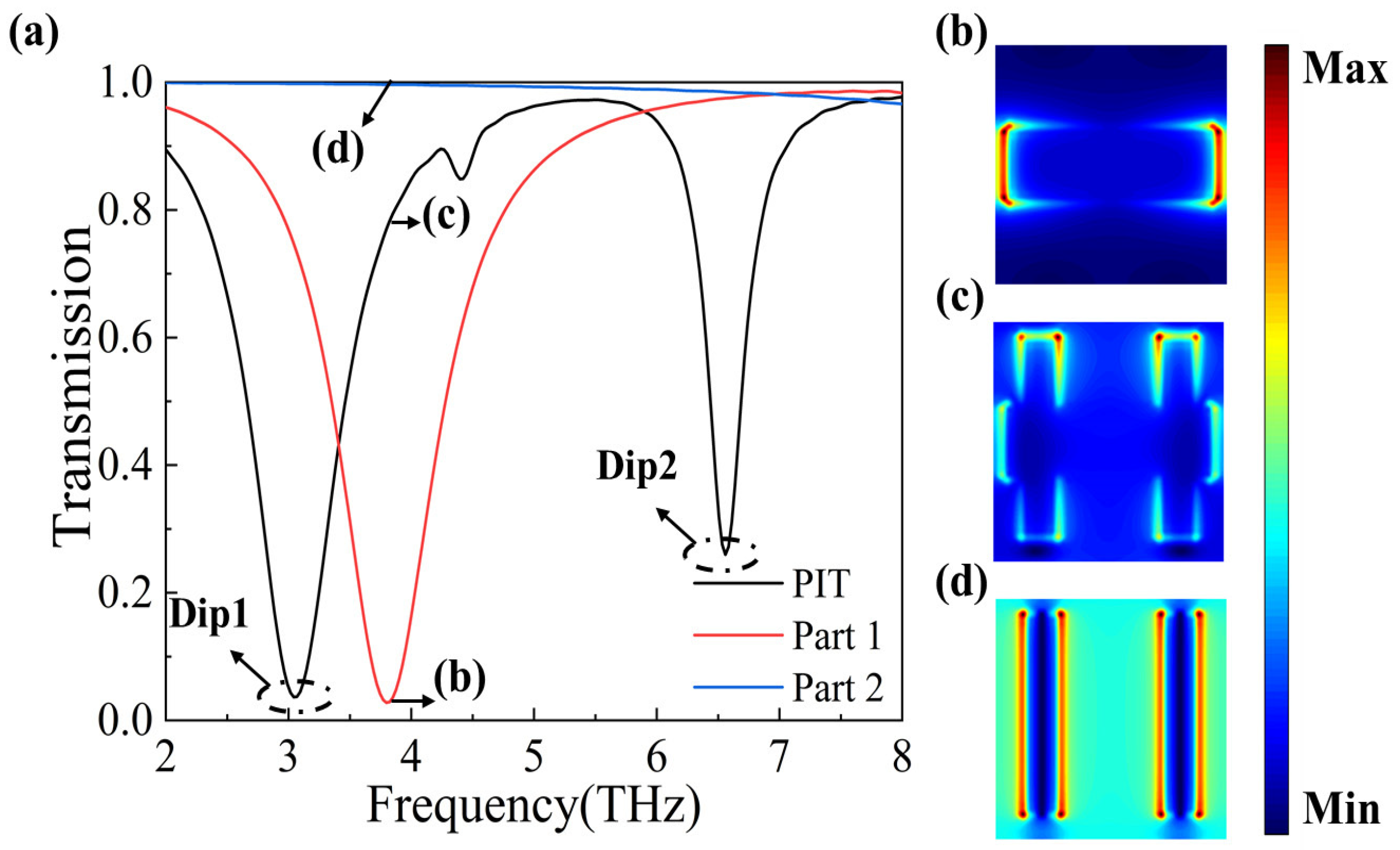

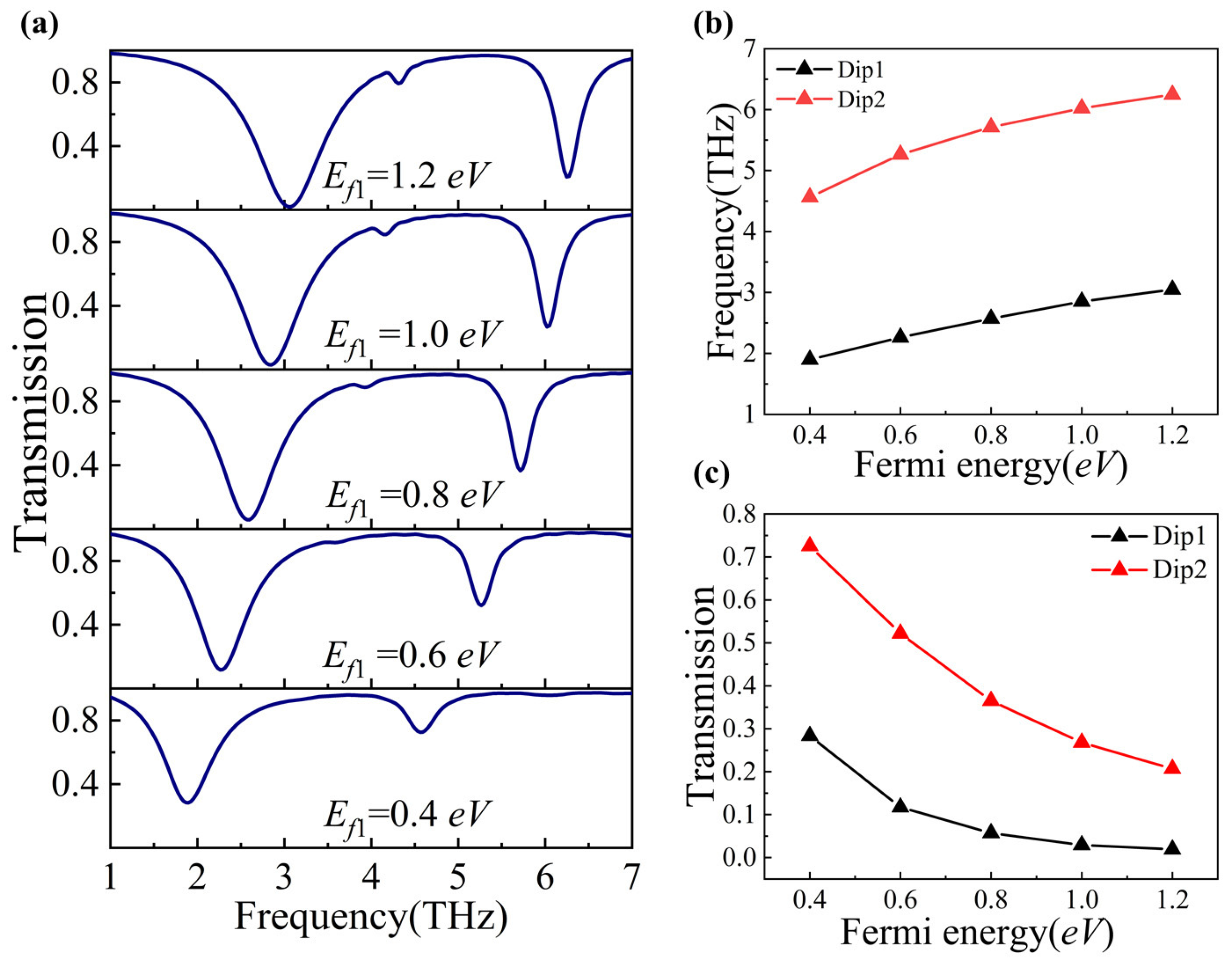
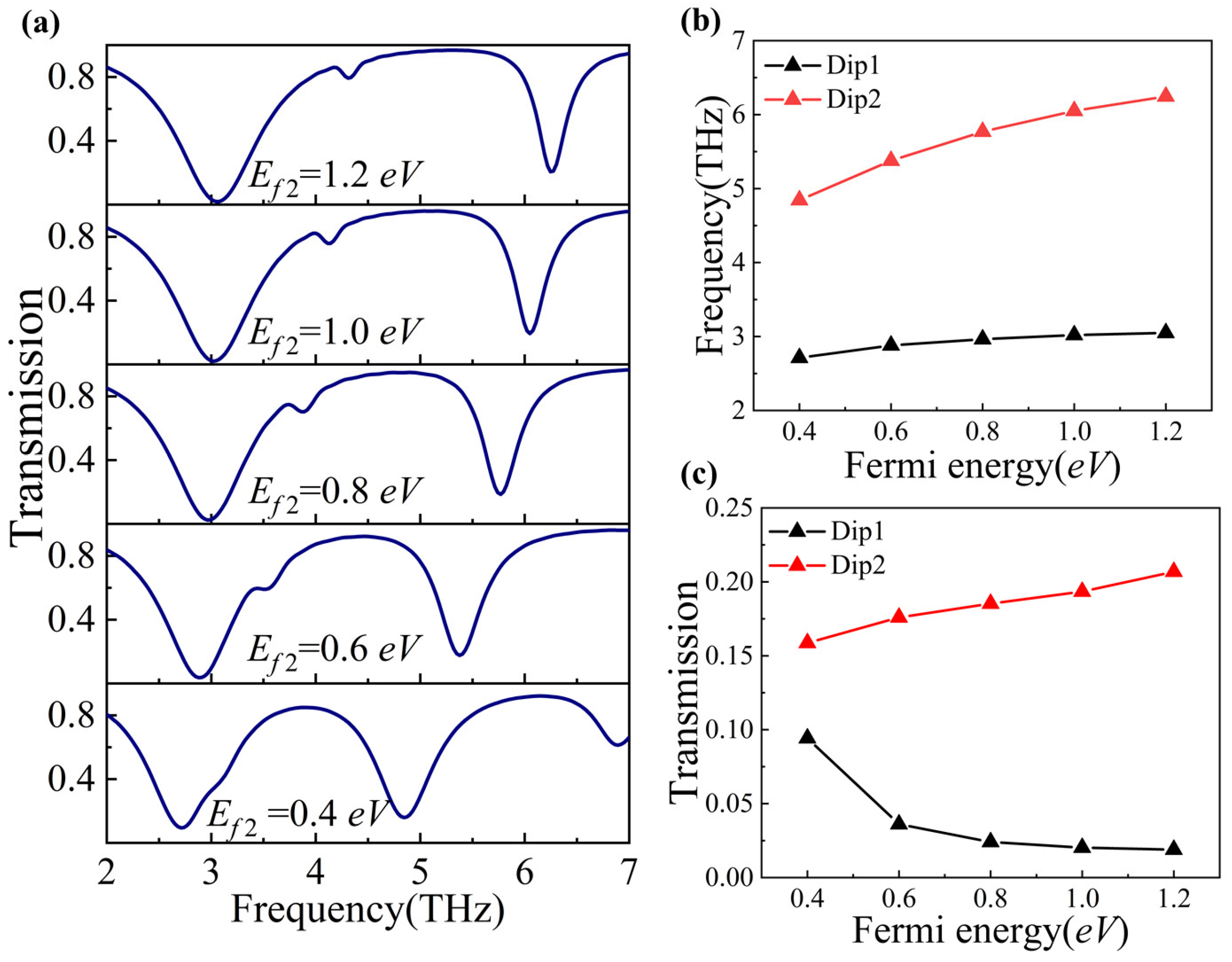


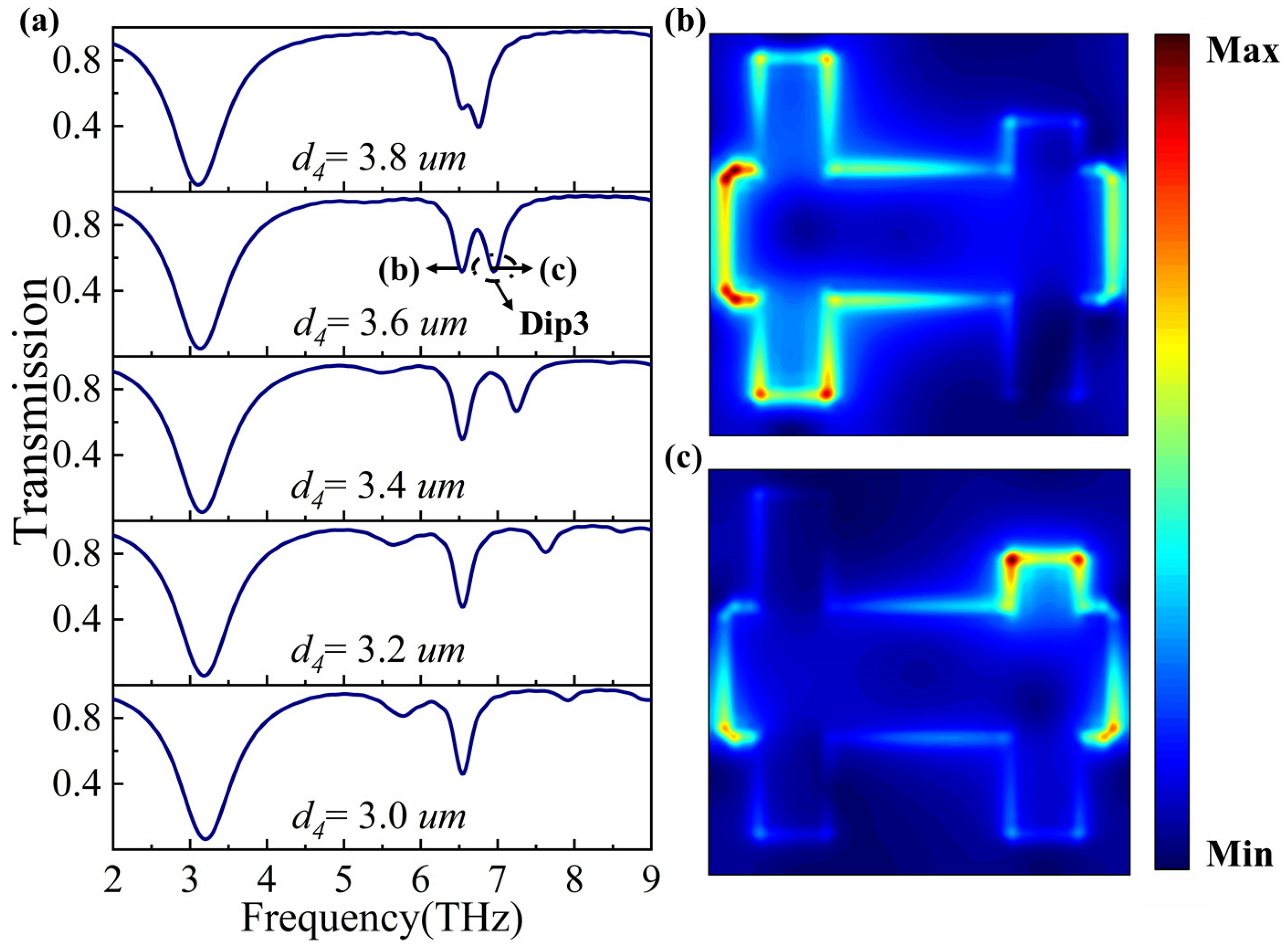

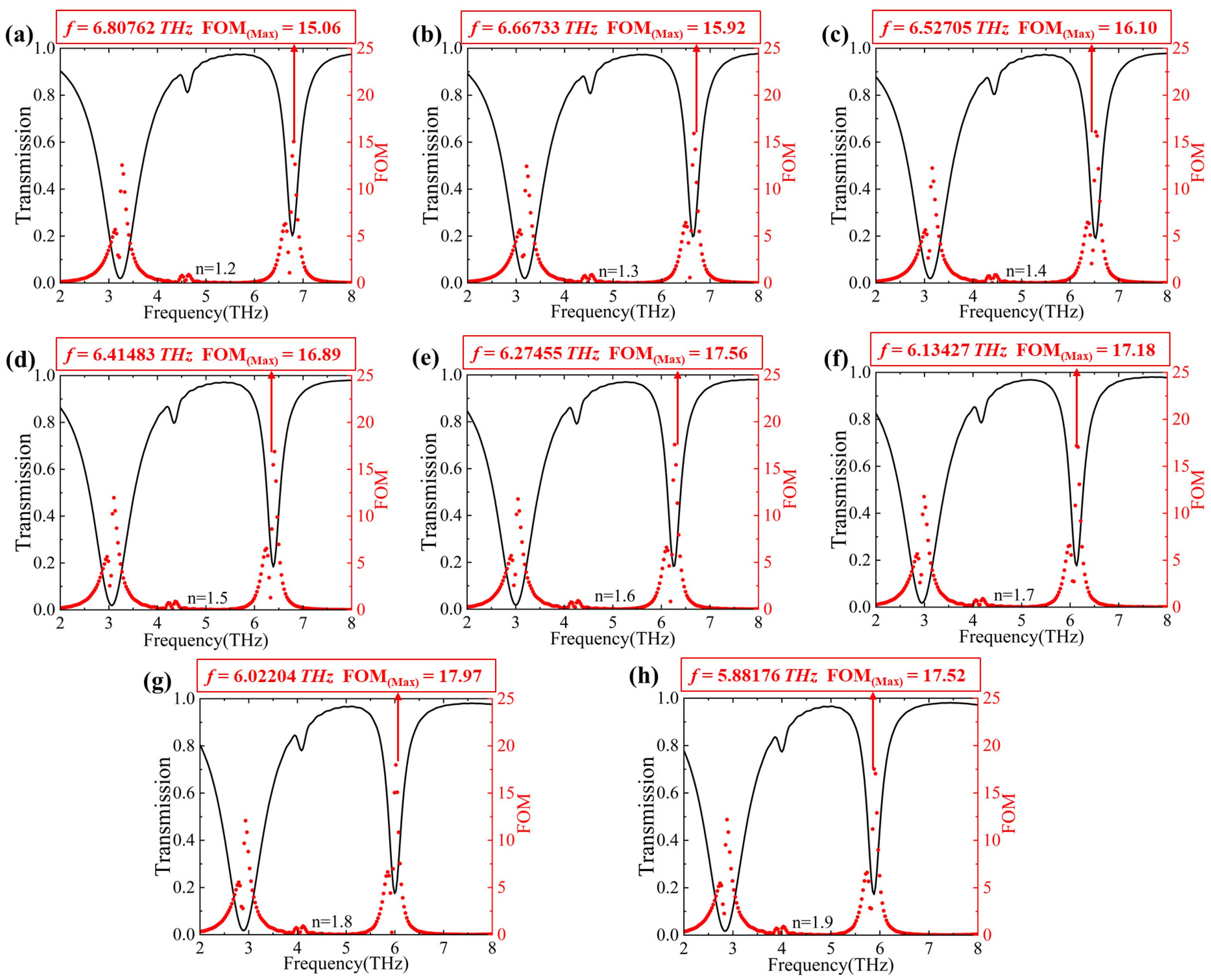
| ∆f1/THz | S1 | ∆f2/THz | S2 |
|---|---|---|---|
| 0.05611 | 0.5611 | 0.14028 | 1.4028 |
| 0.05611 | 0.5611 | 0.11223 | 1.1223 |
| 0.05611 | 0.5611 | 0.14028 | 1.4028 |
| 0.05612 | 0.5612 | 0.14028 | 1.4028 |
| 0.05611 | 0.5611 | 0.11222 | 1.1222 |
| 0.05611 | 0.5611 | 0.14028 | 1.4028 |
| 0.05611 | 0.5611 | 0.11223 | 1.1223 |
| 0.02806 | 0.2806 | 0.14028 | 1.4028 |
Disclaimer/Publisher’s Note: The statements, opinions and data contained in all publications are solely those of the individual author(s) and contributor(s) and not of MDPI and/or the editor(s). MDPI and/or the editor(s) disclaim responsibility for any injury to people or property resulting from any ideas, methods, instructions or products referred to in the content. |
© 2024 by the authors. Licensee MDPI, Basel, Switzerland. This article is an open access article distributed under the terms and conditions of the Creative Commons Attribution (CC BY) license (https://creativecommons.org/licenses/by/4.0/).
Share and Cite
Wu, X.; Chen, J.; Wang, S.; Ren, Y.; Yang, Y.; He, Z. Sensing Based on Plasmon-Induced Transparency in H-Shaped Graphene-Based Metamaterials. Nanomaterials 2024, 14, 997. https://doi.org/10.3390/nano14120997
Wu X, Chen J, Wang S, Ren Y, Yang Y, He Z. Sensing Based on Plasmon-Induced Transparency in H-Shaped Graphene-Based Metamaterials. Nanomaterials. 2024; 14(12):997. https://doi.org/10.3390/nano14120997
Chicago/Turabian StyleWu, Xiongxiong, Jiani Chen, Shaolong Wang, Yang Ren, Yanning Yang, and Zhihui He. 2024. "Sensing Based on Plasmon-Induced Transparency in H-Shaped Graphene-Based Metamaterials" Nanomaterials 14, no. 12: 997. https://doi.org/10.3390/nano14120997





